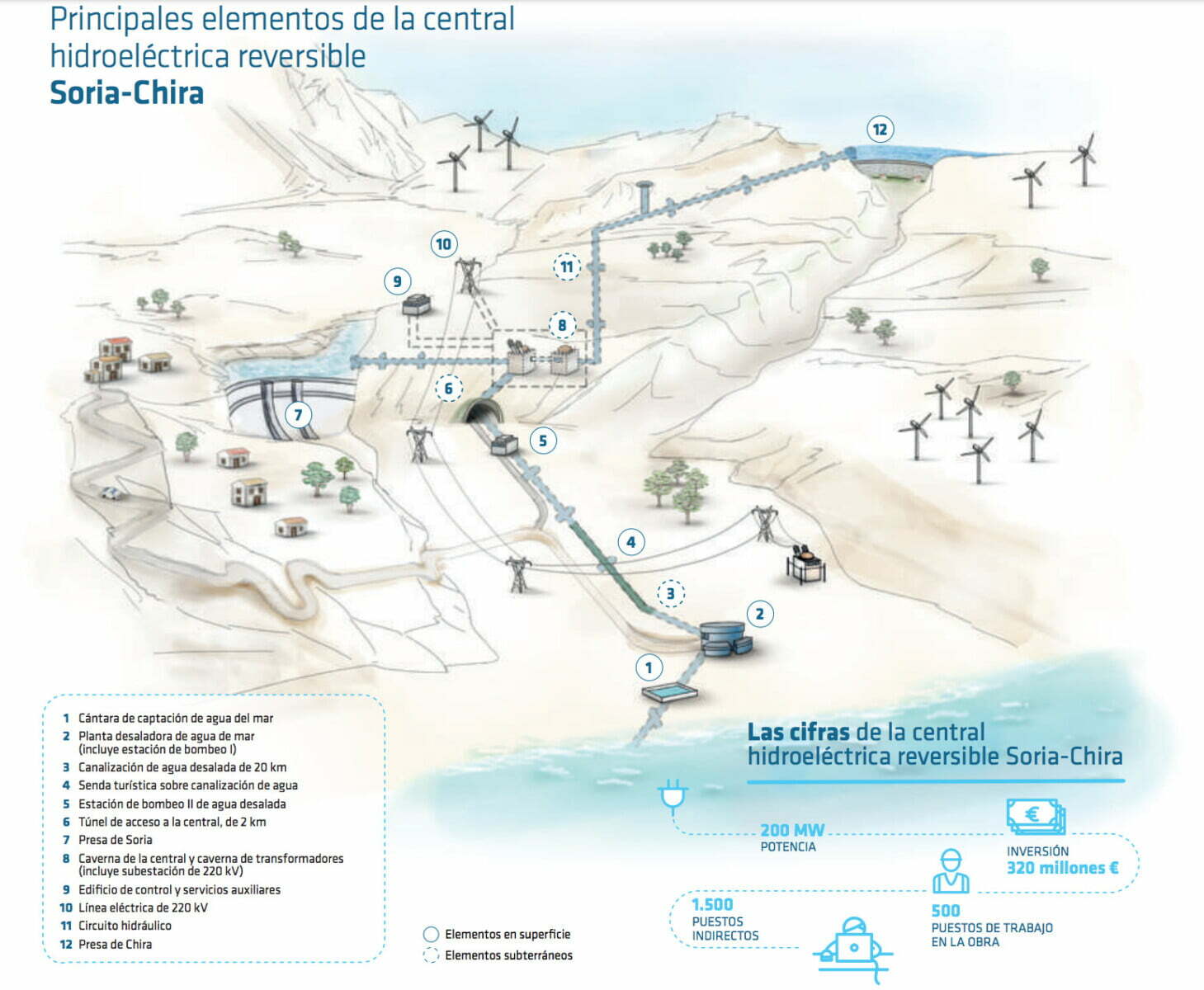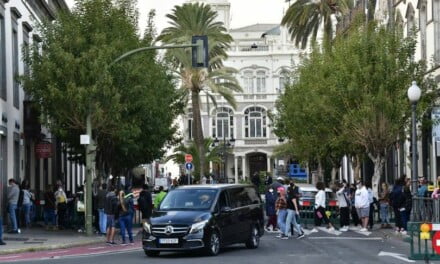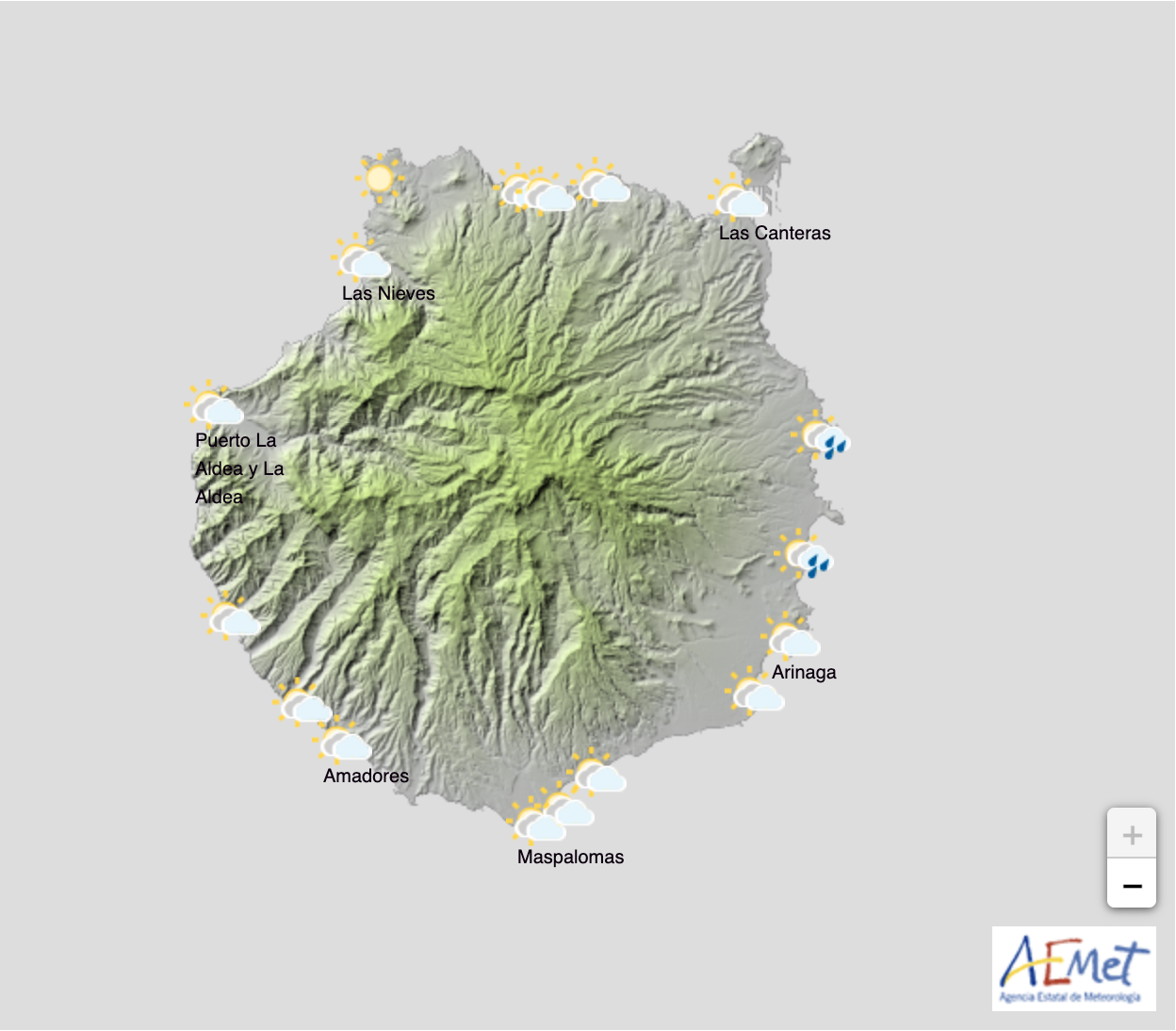- Third vice-president of the Spanish Government, and minister of Ecological Transition and Demographic Challenge, Teresa Ribera, the president of the Canary Islands, Ángel Victor Torres, the president of the Cabildo de Gran Canaria, Antonio Morales, the president of Red Eléctrica de España, Beatriz Corredor and the mayors de Mogán and San Bartolomé participated today in the commemorative act of the start of the works.
- Salto de Chira aims to reinforce Gran Canaria’s supply guarantee and will increase the integration of renewable energies into the system, it is estimated that by 2026 it will be able to increase production with this type of resource by 37% and reduce CO2 emissions by 20%.
- The works, which will last 70 months, involve an investment of more than €400 million and will generate more than 4,300 jobs, including more than 3,500 on the island of Gran Canaria.
Red Eléctrica de España, who oversee the Spanish grid, have announced construction of the Salto de Chira reversible pumped hydroelectric power plant (CHB) is now to begin on Gran Canaria. This is the first major massive energy storage project in the Canary Islands, for the operation of the electrical system, providing greater security of supply and increasing the island’s integration of renewable energies.
 The Government of the Canary Islands, the Ministry for Ecological Transition and Demographic Challenge, the Cabildo de Gran Canaria, Red Eléctrica de España and the municipalities of Mogán and San Bartolomé de Tirajana, have all participated today in a commemorative act at the start of the works, which are set to last 70 months. This milestone completes the administrative process that began in October 2016.
The Government of the Canary Islands, the Ministry for Ecological Transition and Demographic Challenge, the Cabildo de Gran Canaria, Red Eléctrica de España and the municipalities of Mogán and San Bartolomé de Tirajana, have all participated today in a commemorative act at the start of the works, which are set to last 70 months. This milestone completes the administrative process that began in October 2016.
The event was held at the headquarters of the Institución Ferial de Canarias and brought together the third vice-president of the Government and minister for Ecological Transition and Demographic Challenge, Teresa Ribera, the president of the Canary Islands, Ángel Victor Torres, the president of the Cabildo of Gran Canaria, Antonio Morales, the president of Red Eléctrica de España (REE), Beatriz Corredor, the mayors of Gran Canaria, national and regional parliamentarians, as well as a broad business and social representation, from the university, civil associations and irrigation communities, and industry representatives from across Gran Canaria and the Canary Islands.
Third Vice President of the Spanish Government, and Minister for Ecological Transition and Demographic Challenge, Teresa Ribera, highlighted that “the Salto de Chira project is a great example of the path we must take to continue promoting a clean, cheap and efficient energy model. Storage is going to be one of the key pieces of the energy transition, both for its contribution to electrification and for its ability to provide renewable energies with manageability, something especially important in non-interconnected systems such as the Islands. It is at this point where the Salto Chira will represent a great advance, improving the guarantee of supply, the security of the electrical system and renewable penetration. With projects like this, and the firm commitment to renewables”
📣@Teresaribera ha presentado la Estrategia de Energías Sostenibles en Canarias junto con @avtorresp
🗣️”Las soluciones energéticas bien arraigadas e integradas en el territorio son la receta para ganar la batalla al #CambioClimatico “
Va HILO👇🧵 pic.twitter.com/kUrF0j1Mlw
— Transición Ecológica y Reto Demográfico (@mitecogob) February 16, 2022
 Canary Islands President, Ángel Victor Torres, said “this happy day will be remembered as a turning point for the future of Gran Canaria and the Canary Islands as a whole. Because this plant represents progress towards the achievement of many of the fundamental objectives of the Canary Islands Agenda for Sustainable Development 2030. Today, Salto de Chira takes the decisive step to become a reality, after a process that has not been exempt from complexities, due to its scope and its innovative nature. But every effort is worth it if it is to materialise the aspirations of the Agenda, the Declaration of Climate Emergency and the future Law on Climate Change and Energy Transition, which contemplates the decarbonisation of the Islands by the year 2040. That is the way that begins through Salto de Chira”
Canary Islands President, Ángel Victor Torres, said “this happy day will be remembered as a turning point for the future of Gran Canaria and the Canary Islands as a whole. Because this plant represents progress towards the achievement of many of the fundamental objectives of the Canary Islands Agenda for Sustainable Development 2030. Today, Salto de Chira takes the decisive step to become a reality, after a process that has not been exempt from complexities, due to its scope and its innovative nature. But every effort is worth it if it is to materialise the aspirations of the Agenda, the Declaration of Climate Emergency and the future Law on Climate Change and Energy Transition, which contemplates the decarbonisation of the Islands by the year 2040. That is the way that begins through Salto de Chira”
President of the Cabildo de Gran Canaria, Antonio Morales, stressed that “today we celebrate not only the beginning of a great work, but also the beginning of a long-awaited new era: the guarantee that an eco-island model is possible and that we will be able to pass on to future generations a land that we are obliged to protect. Salto de Chira is an essential tool to make possible a model of eco-social progress that guarantees our survival”.
In her speech, the president of REE, Beatriz Corredor, highlighted that “Red Eléctrica will put Salto de Chira into service in compliance with the legal mandate that in 2013 gave the system operator responsibility for these pumping facilities in non-peninsular systems” and has shown that the plant will be “an instrument at the service of Gran Canaria society and a storage tool for everyone and for all”.
The southern Mayors of San Bartolomé de Tirajana, Concepción Narváez, and of Mogán, Ms Onalia Bueno, whose municipalities host the future facilities, also participated in the commemorative act. Bueno stressed that the project “will improve the quality of life of the residents of the Barranco de Arguineguín” while, Conchi Narváez emphasised that “changing the current energy model is something urgent, that we cannot postpone to other generations. One of our great challenges must be to generate the instruments for the storage of clean energy that we generate today”.
 The Salto de Chira plant, declared of being in the general interest by the Government of the Canary Islands, takes advantage of two existing large reservoirs (the Chira and Soria dams) located in the interior of the island, to build between them the 200 MW pumped hydroelectric plant (equivalent to approximately 36% of Gran Canaria’s current peak demand) with up to 3.5GWh of storage capacity. In addition, it includes a seawater desalination station and associated marine works, as well as the necessary facilities for its connection to the hydrological transport network. Water will be an essential element for the operation of the new infrastructure, but it is also a scarce resource in the archipelago. For this reason, the Salto de Chira will guarantee the necessary flow in the reservoirs for the operation of the plant through the water desalination plant that will be installed in Arguineguín, to meet its objective of storing energy. REE say that key infrastructure for the Salto de Chira electricity system in the Canary Islands, has been designed with the utmost respect for the environment, guaranteeing its integration into the environment and minimises the visual impact of the infrastructures, since 91% of them are to be located underground. This infrastructure will reinforce Gran Canaria’s supply guarantee, by increasing the power installed in the system. This is, without a doubt, a fundamental element for an electrical system like the Canary Islands, isolated and, therefore, more vulnerable. Thus, in the event of a supply interruption, the plant will speed up and drastically reduce replacement times. In addition, it will allow increased integration of renewable energies into the system, by taking advantage of the surpluses from this type of source thanks to its storage capacity. In this way, it is estimated that, by 2026, the CHB will be able to increase renewable production by 37%, raising the average annual coverage of demand with this type of generation to 51%, which may be much higher at specific times. Additionally, this will allow a reduction of CO2 emissions by 20%. With an investment of more than €400 million, the facility will generate estimated savings for the electrical system of €122 million per year, by promoting the energy independence of the island and reducing the importation of fossil fuels. In addition, it will generate more than 4,300 jobs, of which more than 3,500 will be on the island of Gran Canaria, contributing to the economic recovery of the Canaries archipelago in a sustainable manner and in line with the principles of the European Green Pact and along the strategic lines and basic principles of the Pact for the Social and Economic Reactivation of the Canary Islands. Aiming to cut fossil fuels in half, in the Canary Islands, by 2030 In recent years, the archipelago has tripled its installed wind power capacity, which, added to photovoltaic, makes a total of 615 MW. This has meant that the coverage of demand with renewables has gone from 7.8% in 2017 to 19.9% in 2021. In this context, the construction of the Chira-Soria pumped-storage hydroelectric plant will be key to promoting the energy transition in the Canary Islands, and moving towards a new energy model that is safer, more efficient, decarbonised and respectful of the environment.
The Salto de Chira plant, declared of being in the general interest by the Government of the Canary Islands, takes advantage of two existing large reservoirs (the Chira and Soria dams) located in the interior of the island, to build between them the 200 MW pumped hydroelectric plant (equivalent to approximately 36% of Gran Canaria’s current peak demand) with up to 3.5GWh of storage capacity. In addition, it includes a seawater desalination station and associated marine works, as well as the necessary facilities for its connection to the hydrological transport network. Water will be an essential element for the operation of the new infrastructure, but it is also a scarce resource in the archipelago. For this reason, the Salto de Chira will guarantee the necessary flow in the reservoirs for the operation of the plant through the water desalination plant that will be installed in Arguineguín, to meet its objective of storing energy. REE say that key infrastructure for the Salto de Chira electricity system in the Canary Islands, has been designed with the utmost respect for the environment, guaranteeing its integration into the environment and minimises the visual impact of the infrastructures, since 91% of them are to be located underground. This infrastructure will reinforce Gran Canaria’s supply guarantee, by increasing the power installed in the system. This is, without a doubt, a fundamental element for an electrical system like the Canary Islands, isolated and, therefore, more vulnerable. Thus, in the event of a supply interruption, the plant will speed up and drastically reduce replacement times. In addition, it will allow increased integration of renewable energies into the system, by taking advantage of the surpluses from this type of source thanks to its storage capacity. In this way, it is estimated that, by 2026, the CHB will be able to increase renewable production by 37%, raising the average annual coverage of demand with this type of generation to 51%, which may be much higher at specific times. Additionally, this will allow a reduction of CO2 emissions by 20%. With an investment of more than €400 million, the facility will generate estimated savings for the electrical system of €122 million per year, by promoting the energy independence of the island and reducing the importation of fossil fuels. In addition, it will generate more than 4,300 jobs, of which more than 3,500 will be on the island of Gran Canaria, contributing to the economic recovery of the Canaries archipelago in a sustainable manner and in line with the principles of the European Green Pact and along the strategic lines and basic principles of the Pact for the Social and Economic Reactivation of the Canary Islands. Aiming to cut fossil fuels in half, in the Canary Islands, by 2030 In recent years, the archipelago has tripled its installed wind power capacity, which, added to photovoltaic, makes a total of 615 MW. This has meant that the coverage of demand with renewables has gone from 7.8% in 2017 to 19.9% in 2021. In this context, the construction of the Chira-Soria pumped-storage hydroelectric plant will be key to promoting the energy transition in the Canary Islands, and moving towards a new energy model that is safer, more efficient, decarbonised and respectful of the environment.
📣@Teresaribera ha participado en la presentación del proyecto hidráulico del Salto de Chira en Gran Canaria 🗣️”Una gran batería que estará en el corazón de Gran Canaria garantizando el recurso cuando se necesita y facilitando la integración de las renovables” pic.twitter.com/XCgVeAlJTZ — Transición Ecológica y Reto Demográfico (@mitecogob) February 17, 2022















